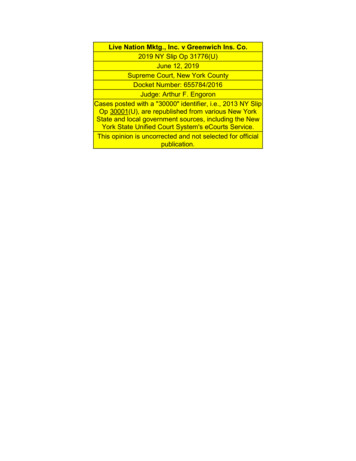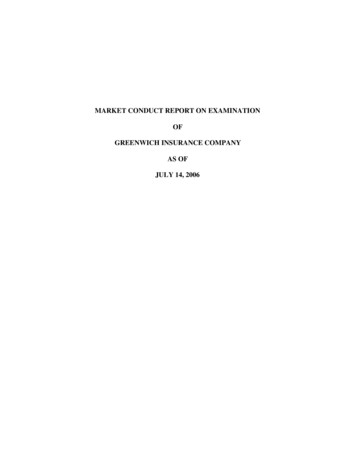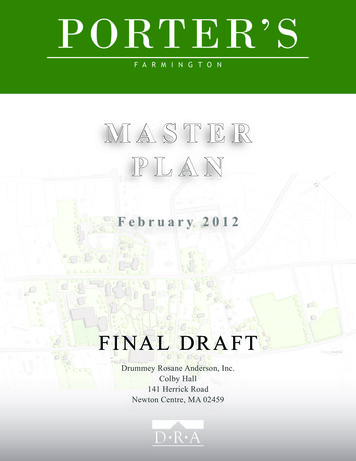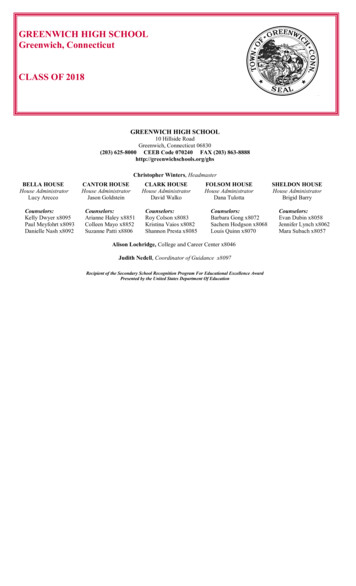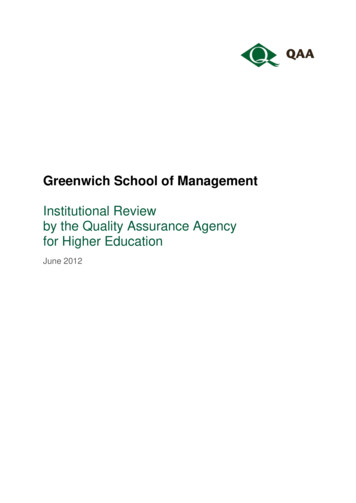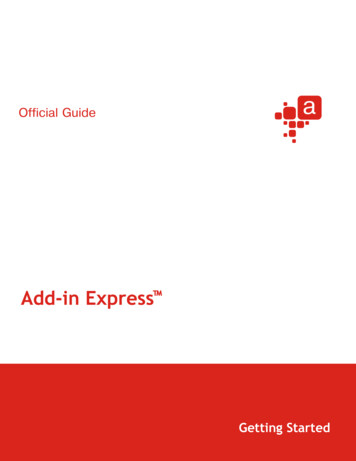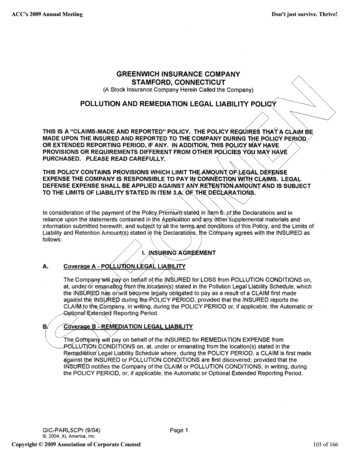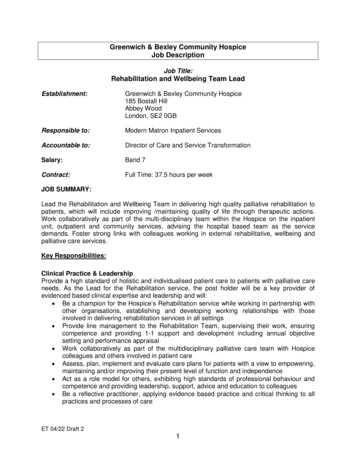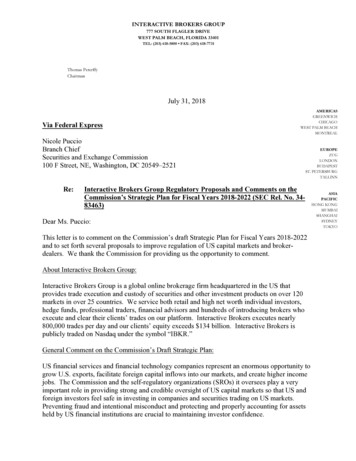
Transcription
INTERACTIVE BROKERS GROUP777 SOUTH FLAGLER DRIVEWEST PALM BEACH, FLORIDA 33401TEL: (203) 618-5800 FAX: (203) 618-7731Thomas PeterffyChairmanJuly 31, 2018Via Federal ExpressAMERICASGREENWICHCHICAGOWEST PALM BEACHMONTREALNicole PuccioBranch ChiefSecurities and Exchange Commission100 F Street, NE, Washington, DC 20549–2521Re:EUROPEZUGLONDONBUDAPESTST. PETERSBURGTALLINNInteractive Brokers Group Regulatory Proposals and Comments on theCommission’s Strategic Plan for Fiscal Years 2018-2022 (SEC Rel. No. 3483463)Dear Ms. Puccio:This letter is to comment on the Commission’s draft Strategic Plan for Fiscal Years 2018-2022and to set forth several proposals to improve regulation of US capital markets and brokerdealers. We thank the Commission for providing us the opportunity to comment.About Interactive Brokers Group:Interactive Brokers Group is a global online brokerage firm headquartered in the US thatprovides trade execution and custody of securities and other investment products on over 120markets in over 25 countries. We service both retail and high net worth individual investors,hedge funds, professional traders, financial advisors and hundreds of introducing brokers whoexecute and clear their clients’ trades on our platform. Interactive Brokers executes nearly800,000 trades per day and our clients’ equity exceeds 134 billion. Interactive Brokers ispublicly traded on Nasdaq under the symbol “IBKR.”General Comment on the Commission’s Draft Strategic Plan:US financial services and financial technology companies represent an enormous opportunity togrow U.S. exports, facilitate foreign capital inflows into our markets, and create higher incomejobs. The Commission and the self-regulatory organizations (SROs) it oversees play a veryimportant role in providing strong and credible oversight of US capital markets so that US andforeign investors feel safe in investing in companies and securities trading on US markets.Preventing fraud and intentional misconduct and protecting and properly accounting for assetsheld by US financial institutions are crucial to maintaining investor confidence.ASIAPACIFICHONG KONGMUMBAISHANGHAISYDNEYTOKYO
Page 2 of 11We could not agree more with the Commission’s primary goal as stated in the draft StrategicPlan, which is to “focus on the long-term interests of Main Street investors” and to “pursueenforcement and examination initiatives focused on identifying and addressing misconduct thatimpacts retail investors.”To that end, we would suggest that the Commission follow a two-pronged approach:emphasizing safety and fair dealing on the one hand and promoting efficient, low cost andaffordable access to securities and financial markets on the other.The Commission is rightly focused on preventing investors from losing money through fraud ormisconduct by intermediaries or other market participants. But the Commission should alsofocus on the money lost by investors due to out-of-control compliance costs, frivolous claims,and the defense of repetitive regulatory inquiries across the industry on minor administrativematters (as these costs that have been imposed on the industry in recent years ultimately areborne by investors).It does not appear that financial regulators in recent years have considered these latter costs at allin determining how to regulate markets and intermediaries. Over the past 10 years or so we haveseen an increasing proliferation of vague and unclear rules and standards on various regulatorytopics with only a tenuous relationship to the core goal of customer and market protection. Thishas been combined with a “broken windows” policing strategy by financial regulators ofbringing cases on many minor or technical administrative violations that do not involvemisconduct or any adverse impact on retail investors.This aggressive enforcement of unclear administrative and technical rules with the seemingprimary intention of collecting fines has caused investors to lose some of the cost efficiency theyshould be capturing through advances in technology. In addition, the recent regulatory approachhas discouraged industry participants from further expansion into new geographic areas,exchanges and products, hampering what should be a strong US export: our safe and innovativefinancial markets.Specific Proposals:1.Regulate Based on Clear, Objective and Transparent Rules.Commission and SRO rules should be clear, objective and transparent so that they can beunderstood easily by compliance staff and, to the extent possible, automated into computer logicso that maximum compliance and investor cost savings can be achieved. Complex and unclearrules, obscure guidance and lore known only to select insiders, and vague and discretionarystandards harm the industry, increase costs and reduce ultimate compliance.It has been common in recent years for Commission regulatory and enforcement staff essentiallyto create new rules and standards based on after-the-fact interpretations or enforcement actions.These new standards are often without support in the language of the actual rules passed by theCommission and are imposed without following required notice and comment rulemakingprocedures (and often seemingly without involvement of the Commission itself). For example,Exchange Act Rule 15c3-5 (the Market Access rule) requires firms to have procedures“reasonably designed to . . . [p]revent the entry of erroneous orders, by rejecting orders that
Page 3 of 11exceed appropriate price or size parameters . . .” Although the rule merely requires proceduresto be “reasonable,” SRO enforcement and audit staff have used the Market Access rule tomicromanage through fines and enforcement actions exactly how broker-dealer routing systemsshould work in various complex and specific circumstances (none of which are addressed in therule or in any written guidance). This and many other “reasonableness” rules thus very quicklybecome strict liability rules in which the broker-dealer’s behavior is measured against standardsthat are developed by SRO or Commission enforcement staff on the fly months or years after thefact.The Commission should ensure that rules and standards are clear, announced in advance, andenacted in a manner consistent with the Administrative Procedure Act. To the extent thatspecific situations arise under particular rules and need to be clarified or modified byCommission or SRO staff, this is understandable but this should be done on a cooperative andprospective basis through clear written guidance, not through ex post facto fines and enforcementactions.2.Emphasize Strict Enforcement of Rules Protecting Clients and Their Assets butWork Cooperatively with Firms to Address Harmless and Minor AdministrativeViolations.The Commission and SROs like FINRA should continue to focus aggressively on detecting andpenalizing fraud and intentional misconduct. Likewise, the Commission and FINRA shouldcontinue to devote significant resources to enforcing capital requirements, segregation and clientasset protection rules. It is critical that retail investors be protected from fraud and that theirassets be strictly protected and accounted for (this includes the many foreign investors who viewthe US as a safe haven and who invest in US businesses and help grow our economy).On the other hand, aggressive and entrepreneurial policing of minor and technical administrativerule violations should be de-emphasized in favor of having Commission and SRO examinationstaff work cooperatively with industry participants to fix lesser administrative problems (or ruleinterpretation problems) on a prospective basis. Backward-looking, formal enforcementinvestigations and fines in matters that do not involve intentional misconduct or harm toinvestors are extraordinarily time consuming and costly both for the regulator and the firms, anddetract from more important work that could be done by everyone involved. Moreover, theseinquiries demoralize honest and hardworking compliance staff, and ultimately reduce confidencein our markets because these repetitive minor cases make everyone look like crooks. While itfills the coffers of the SROs, this approach of aggressively investigating and penalizinginadvertent or technical missteps provides little benefit to retail investors yet raises their cost toinvest, because financial firms must pass along compliance costs to their clients as much as theycan.Instead, regulators should partner with broker-dealers and exchanges to build and modernize theindustry so that investors can benefit from the efficiency, costs savings and investor protectionavailable through technology and automation.
Page 4 of 113.Implement Rules Centrally at the Market or Clearing House Level UsingAutomation as Much as Possible.For the sake of economic efficiency, rules should be enforced centrally and programmatically asmuch as possible, higher up in the processing chain. For example, exchanges should programtheir central matching engines to reject orders that would cause erroneous, out-of-price-rangetrades, instead of the exchanges and the Commission passing vague rules requiring memberfirms each to have to design and program their own order filters based on unclear or nonexistentstandards (which, as noted, only get clarified by repetitive enforcement cases against multiplemember firms after the fact).Likewise, naked short selling abuses and failures to deliver on short sales should be penalized atDTC with gradually increasing daily fines for each security and broker, instead of the current,incredibly complex body of computer code and compliance procedures and staff resourcescurrently required of each broker to comply with Reg SHO. Reg SHO is over 10 years old, withhundreds of pages of FAQs, interpretative guidance, no action letters and the like, and it is stillbeing clarified, revised and patched (over previous patches) by Commission staff. Reg. SHOalone has spawned an entire industry of lawyers, consultants, vendors, enforcement andcompliance staff. Investors are paying for this.4.Anti-Money Laundering Rules Should Be Clarified and Enforced to PreventCriminality and Terrorist Financing but Not to Discourage Foreign Investment inUS Markets.Although the Department of the Treasury largely controls the direction of AML regulation,enforcement staff at the SROs and the Commission increasingly use very broad AML rules tolaunch investigations and enforcement cases against broker dealers – largely based on after-thefact reviews of months or years of emails and transactions and then second guessing whether abroker dealer should have filed Suspicious Activity Reports regarding certain transactions orclients. Likewise, SRO examiners and senior management have taken the position, bothprivately during audits and publicly in various speeches, that foreign clients and cross bordertransactions are, in broad categories, inherently suspicious. This has caused US brokers severelyto curtail their offerings to many classes of foreign clients because the regulatory risk is too great– even if the clear majority of these clients would be proper and lawful investors on US markets.Overzealous enforcement of AML rules and simplistic, overbroad interpretations of whatconstitutes “suspicious” transactions and “red flags” discourages US brokerage firms fromexpanding their services abroad and forces them to push business into their foreign affiliates(which hurts US jobs and tax revenue and discourages capital flows into US markets).There is a happy medium that should be reached between preventing criminality and terroristfinancing while at the same time not unduly hampering foreign client access to US markets andfinancial services. The current approach of essentially forcing private financial institutions tobecome de facto police agencies is misguided. Instead, all transactions should be reported on areal-time basis (with beneficial owner identifiers) to a centralized registry operated by the federalgovernment and actual law enforcement agencies should do the bulk of reviewing thetransactions for indicia of criminality.
Page 5 of 11This approach is consistent with the third goal in the draft Strategic Plan: for the Commission to“elevate the SEC’s performance by enhancing analytical capabilities” and to “enhance [theCommission’s] analytics of market and industry data to prevent, detect and prosecute improperbehavior.”5.The Commission Should Address Payment for Order Flow and Internalization byRequiring Exchanges and Brokers to Publish Simple, Standardized Measures ofTotal Execution Costs.Another way of reducing investors’ expenses would be by promoting competition among firmsthrough transparency -- requiring accurate disclosure of fees and charges and execution cost.Best execution and payment for order flow are significant topics of importance to the MainStreet investors who the Commission rightly focuses on protecting in the draft Strategic Plan.The Commission has struggled for decades with how to treat payment for order flow andinternalization schemes in the context of the best execution of retail customer orders. Classaction plaintiff’s lawyers and state regulators recently have become active in this area.The Commission’s focus on transparency is the correct approach, but the problem is that thevarious disclosures currently required by market centers and brokers are too complex anddisjointed to be helpful to the retail investing public.Exchanges and market centers are required to report complex and elaborate quality of executionstatistics, and brokers are required to report where they route orders and what economicarrangements affect their order routing decisions, but clients cannot as a practical matter piecethis all together to get a clear understanding of execution quality or cost.Likewise, when brokers advertise “free commissions,” clients cannot in any easy way evaluatethe real cost of these free commissions in reduced execution quality for their orders (brokers whoadvertise free commissions are getting revenue from somewhere, after all).We propose that every exchange, ATS/dark pool and internalizer calculate and publish to thepublic the all-in cost of all trades executed relative to the daily Volume-Weighted Average Priceby trade money. This is a simple calculation and a clear simple measure of total execution costthat would automatically account for the total fees and rebates charged/paid by the market, bidoffer spread, market impact and any other costs incurred. In addition to publicly posting the allin cost of all trades executed on the market, the market center could privately make the same dataavailable to each broker trading on the market (for just that broker’s trades).Brokers, in turn, would perform a similar calculation across all venues they trade on and for allorders for all customers and would publish that number (brokers would not be required tocalculate a separate all-in cost for each customer because the sample size of trades compared toVWAP likely would be too small to make the calculation meaningful). Again, this total cost ofexecution would by definition include commissions, regulatory and exchange fees, bid-offer
Page 6 of 11spread and market impact and would allow customers for the first time to see the actualtransaction costs incurred on average to trade through a particular broker.1Since the mid-1980s the concept of the daily Volume-Weighted Average Price has becomeubiquitous and VWAP is now a standard measuring tool for knowledgeable clients and in theacademic community for evaluating execution quality. The virtue of the simple calculation thatwe describe above is that it accounts for all the factors that affect execution cost - including thequality of the execution price, commissions, fees, rebates, etc. This should simplify the debateand eliminate the war of words, accusations and innuendos about various payment schemes, darkpools and broker and marketplace models. Simple data is best, and the simple statisticsdescribed above will allow customers to understand exactly how much they are paying incommissions and other execution costs for the trade execution services their brokers areproviding. Customers can then weigh these execution costs against the value of any otherservices their brokers are providing. Further information on this proposal is attached atAppendix I.6.The Commission Should Balance the Potential Harms and Benefits to RetailInvestors from High Frequency Trading by Requiring a 10-200 ms. RandomHolding Period for Liquidity-Removing Orders on US Equity and OptionExchanges.The recurring controversies in recent years regarding High Frequency Trading (“HFT”) and marketstructure have generated mistrust in the markets and potentially reduced participation by retail investors.Whether HFTs abuse markets or strengthen them is an impossible question to answer because HFTs doboth. A solution is required that both retains HFT participation to the extent that it is productive (i.e., tothe extent it adds liquidity and facilitates price discovery) but eliminates abusive HFT trading. To makemarkets more stable and liquid, the Commission should encourage participation by investors andliquidity providers and discourage abusive ultra-short term strategies that are based solely on the abilityto get an order to a market a few milliseconds faster than others.The Commission should consider requiring U.S. equity and option trading venues to hold any order thatwould remove liquidity for a random period lasting between 10 and 200 milliseconds before releasing itto the matching engine. Slowing down liquidity-removing orders for a minimum of 10 millisecondswould reduce the occurrence of price spikes, “mini-crashes” and runaway markets, because liquidityproviding systems would have more opportunity to intercede. More importantly, a minimum 10millisecond delay would encourage the providers of liquidity to do so because they would know thatthey will have time to adjust their quotes following sudden events. Accordingly, they could provideliquidity in much greater size with less chance of getting scalped by HFTs. With a random delay of 10to 200 milliseconds, ultra-fast HFTs could not with any certainty rely on being able to hit or liftdisplayed bids or offers faster than somewhat slower participants, and therefore HFTs would have muchless incentive to engage in strategies that have no investment purpose except to jump ahead of others bya few milliseconds.On the other hand, where HFTs are acting as liquidity providers, the Commission and othermarket observers have recognized the benefit that they provide in normal markets, but have seen1Note: These statistics would reveal the cost levied by each execution venue and broker but of course would notreveal anything to the public about how much particular customers paid or what any customer’s positions were.
Page 7 of 11that during periods of market turmoil, HFT liquidity often disappears. A delay in processingliquidity-taking orders from 10 to 200 milliseconds would protect HFTs (like other liquidityproviders) from being exposed via their resting quotes during sudden volatility, by giving them areasonable time properly to adjust those quotes before being hit by incoming orders. This wouldencourage them to quote in greater size, it would reduce price spikes and mini-crashes, and itwould restore investor confidence.The short, random delay in processing liquidity-taking orders would also reduce the costlytechnology arms race, in which hundreds of millions of dollars are spent to gain a fewmilliseconds of speed. Those technology costs are borne by investors in the form of widerspreads, execution price slippage and higher commissions.Further detail on this proposal is attached as Appendix II.***We thank the Commission again for the opportunity to comment on the draft Strategic Plan andwe would be happy to provide further information if that would be helpful.David M. BattanExecutive Vice President, LegalInteractive Brokers Group
Page 8 of 11APPENDIX IProposal to Require Brokers, Exchanges and Alternative Trading Systems to CalculateSimple Cost of Execution StatisticsWe propose that the Commission consider requiring all broker-dealers, exchanges and ATS’s tocalculate simple monthly statistics comparing all-in execution cost to the daily VolumeWeighted Average Price (“VWAP”) value for all executions for each month.Market Centers: In addition to publicly posting the all-in cost of all trades executed on themarket (based on the calculation described below), the market center would privately make thesame data available to each broker trading on the market (for just that broker’s trades).Brokers: Brokers in turn would perform a similar calculation across all venues they trade on andfor all orders for all customers and would publish that number on their websites each month.The simple steps described below provide for the calculation of a single number that representsthe all-in execution costs paid to execute trades on a market center or through a broker onaverage over a month (or any significant time period):1.Trade Money: On each trading day, for all purchases and sales of Reg. NMS stocks2,calculate the total shares bought, the total shares sold, the total money paid for all purchases, andthe total money received for all sales. The Trade Money is the amount paid or received,including the execution price plus all commissions and fees3 paid by the participants/customers(and rebates paid back to the participants/customers).2.VWAP Money: Obtain the daily Volume-Weighted Average Price (“VWAP”) for all thestocks purchased or sold on the day. Use this to calculate the total VWAP Money for purchasesand for sales.4 This is the money that would have been paid or received if all trades had beenexecuted at the VWAP, and the customers/participants had paid no commissions or fees, andreceived no rebates.3.Execution Cost: Take the total VWAP Money for sales minus the total Trade Moneyfor sales, and the total Trade Money for purchases minus the total VWAP Money for2For data calculated by brokers, the data would exclude all customers who execute 5,000 or more trades per day onaverage. Customers who execute more than 5,000 trades per day are likely to be HFTs or firms acting as marketmakers and taking the other side of customer trades. The profits of these types of high volume traders (if included inthe broker’s statistics) would likely counterbalance the execution costs borne by other customers of the firm – i.e.,masking the costs paid by the firm’s non-HFT customers.3Fees would include any per-transaction fees charged by the exchanges or broker or fees passed on to the customerby the broker (e.g., regulatory fees, exchange fees, clearing fees, etc.). Likewise, any rebate credited to the customerwould be included. Calculations at the market center level would include all fees and rebates paid to/from themarket center.4I.e., separately for purchases and sales, calculate the total, over all stocks, of the product of the total sharespurchased or sold in each stock and the stock’s VWAP price.
Page 9 of 11purchases. The sum of these two numbers will show the total all-in execution cost incurred in allthe stocks purchased or sold on that day. Note that this is not done on a stock-by-stock basis butrather for all Reg. NMS stock purchases and sales on the day.4.Percentage Execution Cost: Calculate the monthly Trade Money and Execution Cost bysumming the daily values. Compute the percentage of monthly Execution Cost compared to themonthly Trade Money.5 This single number is a measure of the total all-in execution cost paidover the month.5.Lastly, break down the Percentage Execution Cost into two categories: i) Commissionsand Fees; and ii) All Other.6 This will enable customers to see how much they are paying indirect commissions and fees versus how much they are paying in indirect execution costs (priceimprovement or dis-improvement, spread, etc.).5This is done by taking the sum of the daily execution costs and dividing by the sum of the daily sale and purchaseTrade Money.6Commissions and Fees is defined as the total over the month of all commissions plus all fees minus all rebates, alldivided by the total Trade Money. All Other is defined as the Percentage Execution Cost minus the Commissionsand Fees.
Page 10 of 11APPENDIX IIProposal to Address High Frequency TradingThe Commission should consider mandating that U.S. equity and option trading venues hold any orderthat would remove liquidity for a random period lasting between 10 and 200 milliseconds beforereleasing it to the matching engine.Why a Minimum 10 Millisecond Delay in Processing Liquidity-Removing Orders?Slowing down liquidity-removing orders for a minimum of 10 milliseconds would reduce theoccurrence of price spikes, “mini-crashes” and runaway markets, because liquidity-providingsystems would have more opportunity to intercede. More importantly, a minimum 10millisecond delay would encourage the providers of liquidity to do so because they would knowthat they will have time to adjust their quotes following sudden events. Accordingly, they couldprovide liquidity in much greater size with less chance of getting scalped by HFTs.Why Randomize the Delay?If the delay in processing liquidity-taking orders was not randomized (e.g., if it were fixed at 80milliseconds or some other duration), the first person sending out an order would trade first, no matterhow long the delay is. Thus, HFTs would still have all the advantages that they currently havecompared to other liquidity takers.On the other hand, with a random delay of 10 to 200 milliseconds, ultra-fast HFTs could not with anycertainty rely on being able to hit or lift displayed bids or offers faster than somewhat slowerparticipants, and therefore HFTs would have much less incentive to engage in strategies that have noinvestment purpose except to jump ahead of others by a few milliseconds.Why Should the Random Delay Range from 10 to 200 Milliseconds?200 milliseconds are one fifth of a second -- half the blink of an eye -- and about the longest timestill not noticeable by humans. Thus, liquidity-removing orders could be delayed randomly forbetween 10 and 200 milliseconds without an evident slowing of the markets. And since thedelay would be at most 200 milliseconds, brokerage firms and liquidity providers would stillhave to maintain reasonably fast and technologically up-to-date systems: i.e., the markets wouldretain the speed and efficiency that they have gained from electronic trading (and the protectionfrom manual handling errors and fraud) and yet the millisecond-level gaming of the systemwould cease. 7If HFT “A” is faster than Mutual Fund “B” by X milliseconds, it is possible to calculate howlikely it is for A to trade before B under the existing system and under the above proposal:7The rule implementing this proposal would also need to include a requirement that exchanges and broker-dealersimplement surveillance programs to detect and prevent customers from sending in multiple, duplicative liquidityremoving orders for the sole purpose of trying to get an advantageous position in the randomized execution queue(e.g., an HFT wishing to trade 1000 shares sends in 500 orders of 100 shares each so that a few of the orders end upat the front of the random queue. After execution of 10 orders for 100 shares each, the HFT cancels the remaining490).
Page 11 of 11Milliseconds by WhichHFT A’s Systems areFaster than Mutual FundB’s Systems (or B’sBroker’s Systems)Percentage of Time HFTA Will Trade Ahead ofMutual Fund B UnderCurrent Market Structure1 ms. faster2 ms. faster3 ms. faster4 ms. faster5 ms. faster10 ms. faster50 ms. faster190 ms. faster100%100%100%100%100%100%100%100%Percentage of Time HFTA Will Trade Ahead ofMutual Fund B if BothOrders Are RandomlyDelayed from 10 ms. to200 ms.50.5%51%51.6%52.1%52.6%55.1%72.9100%As the table above illustrates, with a random delay in processing liquidity-taking orders therewill still be a slight advantage to having faster systems but it will be greatly reduced and HFTfront-running strategies will be seriously impaired. Spending enormous sums of money to gain a2 or 3 millisecond advantage would be eliminated. For example, even if an HFT’s systems were10 milliseconds faster than a mutual fund trying to do the same trade, the HFT would only tradeahead of the mutual fund around 55% of the time (rather than 100% of the time as in the currentmarket structure). Under the proposal set forth herein, brokers for retail and institutionalcustomers will simply have to make sure that their systems are within 10 or 20 milliseconds asfast as HFT systems. This is already the case and it is reasonable to expect this going forward(the fastest systems can go no lower than 0).
INTERACTIVE BROKERS GROUP 777 SOUTH FLAGLER DRIVE WEST PALM BEACH, FLORIDA 33401 TEL: (203) 618-5800 FAX: (203) 618-7731 . Chairman July 31, 2018 AMERICAS GREENWICH Via Federal Express CHICAGO WEST PALM BEACH MONTREAL Branch Chief EUROPE Securities and Exchange Commission ZUG LONDON 100 F Street, NE, Washington, DC 20549-2521 BUDAPEST .
